Pelvic inclination - what's behind it?
introduction
Overall, the pelvis represents the connection between the spine and the legs and is of great importance for the overall stability and posture of the human body.
The pelvis is often not completely symmetrical in the horizontal axis, which is known as pelvic inclination. According to studies, this is the case with the majority of people, but usually the inclination is only slightly pronounced and does not cause any further complaints.
If, on the other hand, pain or other complaints occur, one speaks of a pathological pelvic obliquity. A distinction is made between two forms, the functional and the structural pelvic inclination.
- In structural pelvic inclination, there is usually a leg length difference, which means that the legs are of different lengths.
- The functional pelvic inclination, on the other hand, comes about due to muscular tension, incorrect posture or even diseases such as scoliosis (i.e. a curvature of the spine).

What causes the pelvic tilt?
Many factors come into question as causes of a pelvic inclination.
- A structural pelvic inclination, for example, is usually based on a leg length difference, which is usually due to the patient's condition. In order to still enable a straight and upright posture, the body adapts to this situation by tilting the hips.
Legs of different lengths are not always pathological. Only when the difference exceeds a certain value does it usually lead to complaints. A few millimeters usually do not cause any problems, but from a difference of about six to seven millimeters or more this should be clarified in more detail in order to prevent long-term incorrect loads at an early stage.
- The difference in leg length can also only be acquired in the course of life, for example through an accident, prostheses or other diseases such as osteoarthritis in large joints.
- A functional pelvic inclination is more likely due to the imbalanced interaction of muscles and ligaments, which ultimately causes poor posture.
- Often one-sided tension in the muscles in the buttocks or in the lumbar spine area leads to an incorrect position of the pelvis. Contributing factors for this are very long periods of sitting, lack of exercise and poor posture, such as at the computer. If the tension is released or removed again, the pelvic inclination usually also disappears.
- Another cause of functional pelvic obliquity can also be scoliosis. On the one hand, it can cause a pelvic obliquity, but it is also possible that a pelvic obliquity leads to scoliosis in the long term due to the associated incorrect posture of the spine.
Read more on the topic: Scoliosis
What are the symptoms of pelvic obliquity?
Muscle tension in the lumbar spine
The pelvic inclination clearly has an impact on the muscle groups in the lumbar spine and can cause muscle tension there.
The more pronounced the inclination of the pelvis, the more the weight of the abdominal organs shifts to the detriment of the posterior abdominal wall. This means a greater load on the bones and muscles of the lumbar spine.
It is worrying that muscle tension and the pelvic inclination are mutually dependent and mutually aggravated, which is why therapeutic intervention must be made early on.
Also read our topic: Lumboischialgia
Appointment with a hip expert?

I would be happy to advise you!
Who am I?
My name is dr. Nicolas Gumpert. I am a specialist in orthopedics and the founder of .
Various television programs and print media report regularly about my work. On HR television you can see me every 6 weeks live on "Hallo Hessen".
But now enough is indicated ;-)
The hip joint is one of the joints that are exposed to the greatest stress.
The treatment of the hip (e.g. hip arthrosis, hip impingement, etc.) therefore requires a lot of experience.
I treat all hip diseases with a focus on conservative methods.
The aim of any treatment is treatment without surgery.
Which therapy achieves the best results in the long term can only be determined after looking at all of the information (Examination, X-ray, ultrasound, MRI, etc.) be assessed.
You can find me in:
- Lumedis - your orthopedic surgeon
Kaiserstrasse 14
60311 Frankfurt am Main
Directly to the online appointment arrangement
Unfortunately, it is currently only possible to make an appointment with private health insurers. I hope for your understanding!
Further information about myself can be found at Dr. Nicolas Gumpert
Pain when the pelvis is inclined
Probably the leading symptom of a clinically relevant pelvic obliquity is pain.
This is mostly primarily back pain.
These in turn often lead to incorrect posture and incorrect strain, which in the long term can lead to other parts of the body being affected.
For example, in addition to the original back pain, those affected then complain of neck and shoulder pain with frequent resulting tension headaches.
In some cases, however, those affected also experience pain in the legs, such as in the knee or ankle.
The pain symptoms usually occur after long periods of sitting or standing and are primarily an expression of wear and tear on the joint structures.
In the long term, this means that the pain will not get better or even go away in the untreated condition; it will usually only get worse through the long-term exposure.
SI joint pain
A common consequence of pelvic obliquity is pain in the sacroiliac joint. The ISG - also known as the sacrum and the iliac joint - is the connection between the lower spine and the pelvic ring.
Congenital malpositions, chronic poor posture and muscle weakness lead to painful muscle tension and relieving posture. The inclined position of the pelvis in particular causes an imbalance of the muscles and the associated improper stress in the hips. Among other things, this can lead to irritation of the joint capsule with subsequent inflammation.
After a long malposition, the development of an SI joint blockage can be favored - a painful functional restriction of the SI joint which can be counteracted preventively with muscle training.
You might also be interested in these topics:
- ISG blockage
- ISG syndrome
Pain in the buttocks
The gluteal muscles are responsible for the physiological posture of the pelvis. On the one hand, weakness in the gluteal muscles can cause the pelvis to tilt. On the other hand, a pelvic obliquity can cause a painful imbalance of the gluteal muscles.
In the long term, this means that mobility in the hips is restricted. A herniated disc can be a dreaded complication.
Here, too, the cycle must be broken by building muscle to ensure stability in the hip joint.
More on this: Pain in the buttocks
Pain in the leg
The pelvic inclination leads to unequal load in the legs and a muscular imbalance. As in all parts of the body, a disproportion in the muscular structure leads to tension in the legs and the resulting relieving posture.
Chronically, this improper load causes accelerated joint wear, especially in the knees, with an increased risk of osteoarthritis. Physiologically, the hip, knee and foot should lie in an anatomically measurable axis to one another. Since this axis is disturbed when the pelvis is inclined, there is incorrect loading and pain in all three areas.
You might also be interested in this topic: Pain in the legs
Groin pain with pelvic obliquity
Groin pain can be a common symptom of pelvic obliquity.
Basically, an inguinal hernia, muscular tension in the hip area and hip arthrosis should be considered in the differential diagnosis of groin pain.The inguinal hernia - the protrusion of the abdominal viscera through a connective tissue weak point in the groin area - can easily be ruled out with an ultrasound.
Since many muscles are attached in the area of the inguinal ligament, pain can easily arise here too in the event of improper loading when the pelvis is inclined. The pain often radiates into the leg on the same side and getting up from a sitting position causes many problems for the patient.
Additional pain radiation in the groin can be caused by hip joint arthrosis, which in turn can be the result of years of incorrect loading in the case of pelvic obliquity.
You can also find out more at: What are the symptoms of an inguinal hernia?
Diagnosis of pelvic obliquity
To diagnose a pelvic obliquity, an orthopedic examination is first carried out by the attending physician.
He assesses the spine and the pelvic bones and can determine, for example by palpation, whether there are curvatures, asymmetries or other deviations from the normal findings.
Even a trained eye can recognize muscle tension or subtle signs of a misalignment simply by looking.
If there is a suspicion of a leg length difference, both legs are measured in order to precisely quantify the difference.
There are also imaging methods that enable a more precise assessment for further clarification.
On the one hand, an X-ray examination, for example, is a good one structural pelvic inclination detect.
Another method is the so-called 3D spine measurement.
With this, the doctor can use beams of light that are projected onto the patient's back and pelvis to display a very detailed, three-dimensional image on the computer. The greatest advantage of this method is certainly that it completely dispenses with X-rays.
This makes it particularly suitable for children and for frequent follow-up checks.
Treatment of pelvic obliquity
The treatment of pelvic obliquity can look very different. Basically, however, it is only treated if the pelvic inclination actually leads to discomfort or if it is so great that the spine warps to compensate for it.
To choose the right therapeutic approach, the exact cause must first be clarified in advance.
For example, if there is a structural pelvic inclination due to a difference in leg length, the primary goal of treatment is to compensate for this difference. If this is only a few millimeters up to a maximum of about one centimeter in size, this can usually be easily compensated for with orthopedically individually adapted shoe insoles.
However, after the insoles have been put in place, a follow-up should be carried out to check whether the insoles really fit well and lead to the desired goal.
If this is not the case, the orthopedic surgeon has the option to make adjustments at any time and thus exclude artificially generated incorrect loads.
However, if the difference in leg length is slightly larger and up to three centimeters, the orthopedic surgeon usually recommends raising the heel or shoe sole.
If the leg length differences are even greater, the possibility of corrective surgery should be considered.
However, this is a very lengthy treatment concept, which is why this option should only be used if the symptoms are appropriate.
If, on the other hand, it is a functional pelvic inclination, the treatment concept is completely different.
Often there is underlying muscle tension, which is mostly localized on one side. These can be relaxed with the help of targeted physical and occupational therapy.
In addition, through targeted training you can train important muscle groups on the opposite side and thus achieve an upright, stable posture in the long term.
Then the pelvic inclination and the corresponding consequences usually disappear again on their own. Movements in everyday life are also trained in order to avoid chronic inappropriate strain.
And last but not least, relaxation exercises such as yoga can also have a supportive effect.
If the functional pelvic inclination is due to scoliosis, this should be treated first. Possible therapeutic approaches for this would be wearing a spinal corset on the one hand, but physiotherapy with physiotherapeutic exercises to strengthen muscles are also of great importance.
The treatment concept for scoliosis also depends on the age of the person affected and the severity of the curvature itself.
As a very last option, there is also the possibility of surgery. However, this is usually only carried out with very pronounced curvatures of the spine.
Correct pelvic inclination
Another form of pelvic inclination can be caused by a mechanical blockage, also called dislocation arise.
By definition, this is also one functional pelvic inclination. However, this can be done relatively easily using manual therapy be treated.
This should be done by an experienced person who can then usually correct the affected joint with a special handle.
The surrounding musculature, which may have been tensed up due to the blockage, then relaxes by itself when it is reduced and the pelvic obliquity is completely eliminated in most cases.
Deposits for a pelvic inclination
Insoles or raised soles should always be used when symptomatic Leg length difference consists. In this way, a compensation can usually be created in which the previously inclined pelvis disappears.
Also chronic inappropriate loads with increased signs of wear and tear can be prevented relatively easily and at an early stage. However, the insoles should always be prescribed individually by an orthopedic surgeon and, if necessary, adjusted in the course of check-ups.
Exercises against pelvic inclination
To counteract a worsening of the pelvic obliquity and its effects, there are simple physical exercises that should be performed regularly.
As a basis for the training, diagnostics by the orthopedic surgeon is essential and in the best case scenario, measures to compensate for the deformity have already started. This can be, for example, deposits or a restriction.
- A very practical exercise for the shorter, weaker leg that can be integrated into everyday life is the one-legged stance, for example when brushing your teeth.
- It is also important to loosen the hip joints, for example by stretching the muscle groups.
To do this, from the four-legged position, you can put the shorter leg forward on the floor at a 90 degree angle, with the knee facing outwards. The other leg is stretched straight back and the upper body is leaned forward so that a noticeable stretch takes place.
- In addition, while standing you can bend one leg back, grasp your ankle with your hand and push your pelvis forward to stretch.
Ideally, these exercises are carried out in conjunction with physiotherapy treatment and regular medical check-ups. Basically, most pelvic inclinations are not genetic, which is why muscular training can often help against poor posture.
You may also be interested in this topic: stretching
How can osteopathy help with pelvic obliquity?
Basically, the approach of osteopathy can be divided into three major areas, which merge into one another in many places and the focus of which is the therapeutic intervention with targeted hand movements by the osteopath. The three areas are divided into “cranio-sacral therapy”, visceral and parietal therapy.
With regard to the pelvic inclination, the "Cranio-Sacral Therapy" deals with the effects of the misalignment on the head and nervous system. Since patients often experience a tension headache or tinnitus due to neck posture, relief can be achieved, among other things, by treating the neck muscles.
Visceral therapy is dedicated to the internal organs that are affected by the deformity.
Parietal osteopathy as a third approach focuses on the musculoskeletal system. Here the examiner is primarily concerned with pushing and pulling movements of his hands, which are intended to release joint blockages and muscular tension.
As with many therapeutic approaches, the success of osteopathy also depends on the individual physical condition and the extent of the deformity.
OP with pelvic inclination
In rare cases, surgery to treat pelvic obliquity can be considered.
During this operation, a growth plate is artificially drilled into the thighbone of the shorter leg in order to then force bone growth at this point by applying lag screws. The screws are attached directly to the bone and are intended to fix it on the one hand and exert a slight pull on the other.
This system is also known as automated internal fixator, as this built-in system can be adjusted from the outside using a suitable program.
In most cases, those affected can leave the hospital a few weeks after the operation and only have to go to the orthopedic surgeon for check-ups, who then adjusts this system again and again. Overall, however, this type of therapy can drag on for several years.
Pelvic obliquity during pregnancy
Pregnancy usually involves many physical changes that also affect muscles, affecting everyday movements, running, and posture. The frequent occurrence of back pain during pregnancy cannot be traced back to any clear cause.
In recent years a number of clinical studies have been carried out on pelvic inclination during pregnancy with the result that the measurable parameters of pelvic inclination are not significantly worsened by pregnancy. Nevertheless, it is certain that pregnancy and childbirth place an increased strain on the joints of the pelvis and a significant weakening of the muscle groups involved and the connective tissue.
Good medical and physiotherapeutic care during and after pregnancy is all the more important in order to prevent further problems with good pelvic floor and hip muscle training. Possible risks due to the pelvic inclination in relation to delivery must be weighed up in consultation with gynecologists and orthopedists, depending on the individual findings.
You can also find out more at: Back pain in pregnancy
Consequences and effects of a pelvic inclination
The most common consequence of a pelvic tilt is the pain symptoms described above.
However, if the inclination persists for a long time, the chronic consequence can also develop into scoliosis (i.e. a curvature of the spine).
This occurs because the back tries to permanently compensate for the incorrect posture. Due to the special structure of the spine, this usually works relatively well.
If this situation persists, however, the increased wear and tear leads to remodeling processes and curvature of the spine, which are usually no longer easily reversible.
In addition, scoliosis is usually perceived as quite painful by those affected while it develops.
Once the scoliosis has developed, the spine is in a lateral curvature, which in turn can lead to further complaints.
For example, there can then be herniated discs, changes in the vertebral body joints and even nerve entrapment, which in turn can be associated with loss of sensitivity.
In addition, signs of wear and tear can also occur in the joints of the pelvic ring itself (sacroiliac joint, SIJ) or in joints below such as the knee joint or the ankle.
These are usually associated with cartilage damage and permanently restrict the movement of the affected extremity.
Scoliosis due to a pelvic obliquity
Scoliosis is the medical term for an abnormal angle of curvature of the spine to the side and the rotation of the vertebral bodies. It is noticeable that scoliosis and pelvic obliquity often occur together.
The cause of scoliosis has not yet been clearly clarified, but a genetic component can be assumed.
In the idiopathic form of scoliosis, it is assumed that hormonal imbalances are responsible for growth spurts that have pathological effects on the spine.
In myopathic or neuropathic scoliosis, muscular imbalances and the associated incorrect posture are probably the cause of the development of scoliosis.
The inclination of the pelvis should therefore also be mentioned as an important triggering factor.
Read more on the topic: Scoliosis
Which doctor treats pelvic obliquity?
If you suspect a pelvic obliquity, you can either consult your family doctor or contact an orthopedic surgeon directly. He has specialized in the human musculoskeletal system.
The most important diagnostic devices are usually located in an orthopedic practice or clinic. In the case of long-standing back pain and poor posture, the doctor can then clarify other important differential diagnoses.
In the further course, the long-term connection to a physiotherapy practice is also important, as the right muscular training is essential for a successful therapy.
Summary of the pelvic inclination
As a basin (also: Pelvis) is generally used to describe a group of three bones that form a functional unit with one another.
These are on the one hand the two hip bones with the hip scoops and in the middle the sacrum. Together they form the so-called pelvic girdle or pelvic ring. Pelvic inclination can have various underlying causes. A basic distinction is made between a structural and a functional pelvic inclination.
Read more on the topic: Pelvis anatomy
The diagnosis is usually associated with little effort and can be designed very gently for the patient without radiation exposure.
Depending on the cause, different therapy concepts are available, but in most cases good results can be achieved with professional application.
The prognosis of a pelvic obliquity is therefore very good overall with early therapy and in many cases even completely reversible.
Recommendations from the editorial team
- Leg length difference
- Scoliosis
- pool
- Spine
- Diseases of the hip



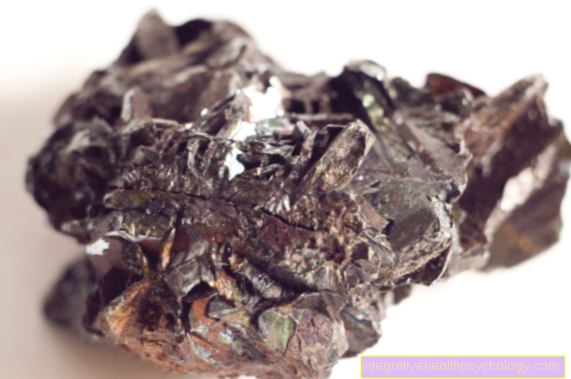
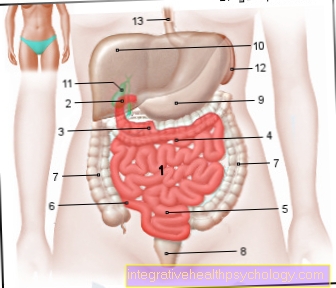



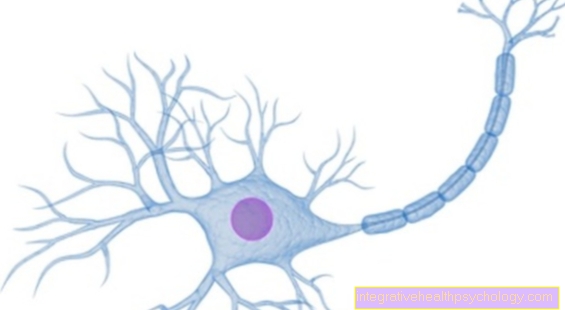


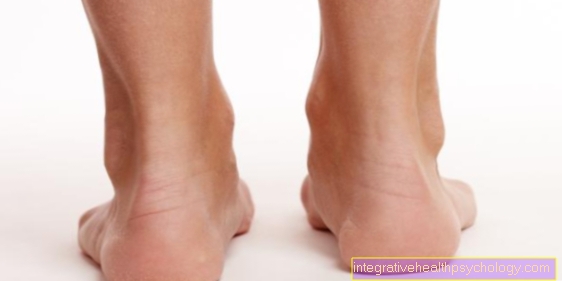




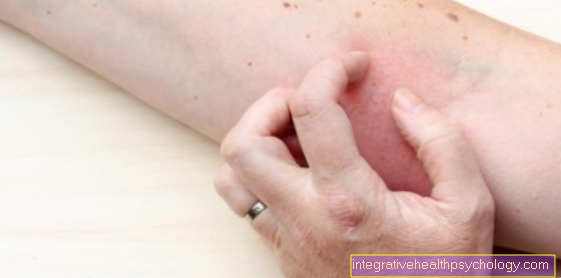




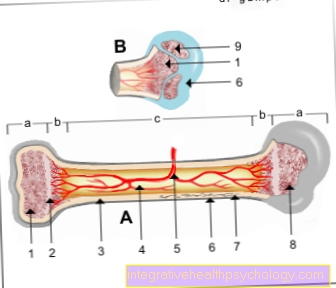
.jpg)






